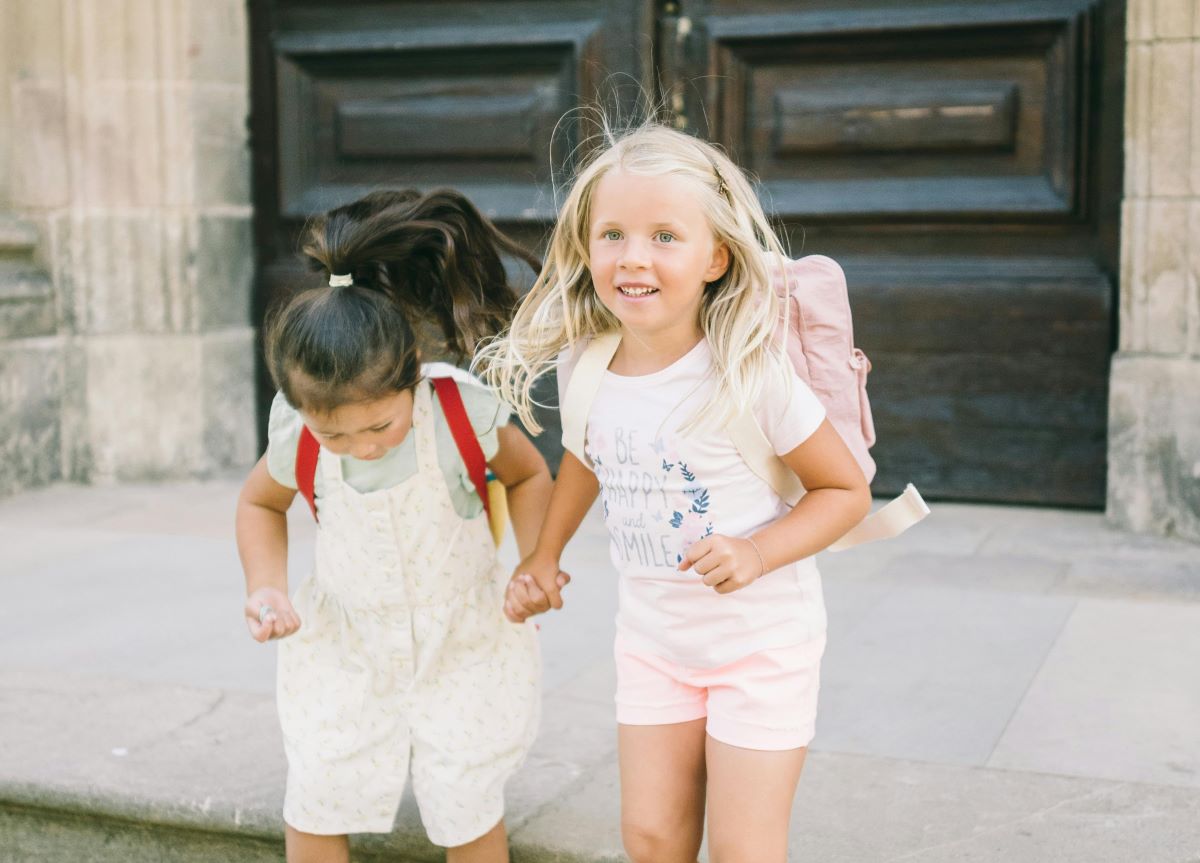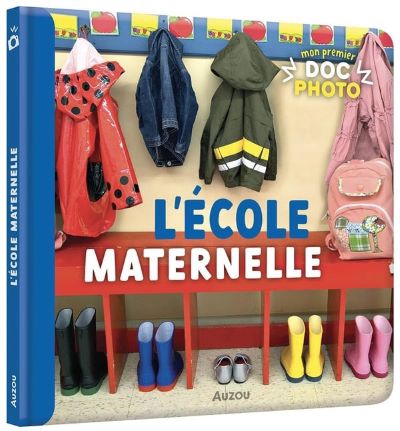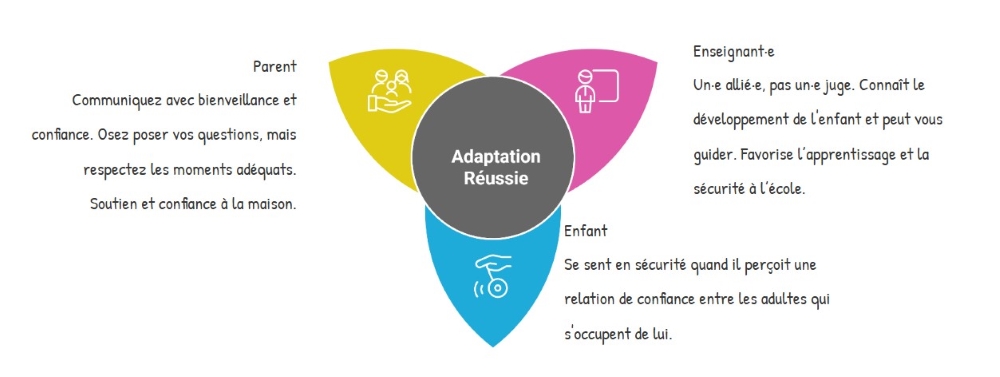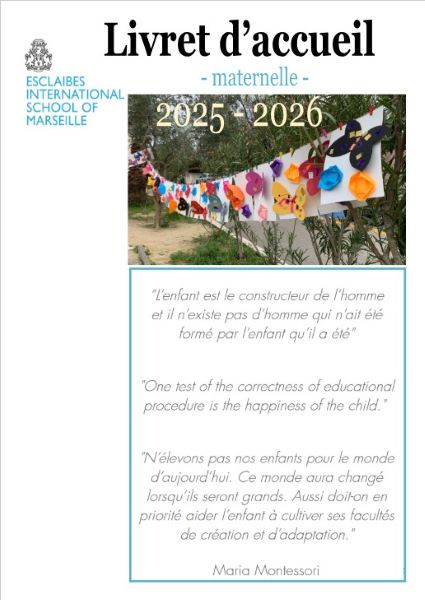3-6 years
News
Montessori
Marseille
Preparing for the first day of kindergarten
August 25, 2025

Preparing for the start of nursery school: step-by-step support for your child
The first day of kindergarten is a big moment in a child's life... and in that of his or her parents. Between excitement, pride and sometimes apprehension, this symbolic passage marks the start of a new adventure made up of discoveries, encounters and learning. But it can also be a source of concern for children and parents alike! How do you prepare your child for separation? How can we help them adapt to a new environment, new rules and new adults?
The good news is that, with a littleforethought, a lot of kindness and a few simple points of reference, it's possible to turn this first day of school into a smooth, reassuring experience for the whole family.
Understanding the challenges of the first day of kindergarten
A key stage for the child... and for the parents
The first day of kindergarten marks an important stage in a child's development. It opens up a new space for discovery, a place where they will learn:
- learning to live in a community (or continuing this learning if he was in day care);
- cooperate with other children;
- develop language and motor skills;
- but also to gradually assert themselves as students.
It's also a symbolic moment: school becomes a new living environment, different from the home or nursery.
For parents, it's also a momentous occasion. Seeing your child walk through the classroom door, sometimes with a little backpack that's bigger than he or she is, can arouse emotion and pride, but also anxiety. It's the start of a new relationship in which the child takes on more autonomy, and parents have to agree to "let go" a little more.
The importance of the parental mindset
Let's not forget that our children are real "emotional sponges". They sense our joys, worries and apprehensions. If the parent experiences the start of the new school year with a great deal of anxiety, the child will feel it, which can make the separation more difficult.
Conversely, if the parent conveys confidence and serenity, the child will be reassured and better able to explore this new world.
It's not a question of denying our own emotions as parents - it's normal to be moved or worried, which can be the case if our own relationship with school has been complicated. The important thing is to strike a balance: acknowledge your own feelings, while showing your child that school is a safe place, conducive to his or her development.
Separation: a gradual learning process
Starting kindergarten is often the first real and prolonged separation between a young child and his or her parents. For some, this is a fairly natural step, especially if they have already attended a crèche or nursery assistant. For others, it can be a source of tears and anxiety.
Separation is a learning process in itself. As with walking or talking, each child progresses at his or her own pace. Morning crying, frequent in the first few weeks, is not a sign of failure, but the expression of a strong emotion. They generally subside rapidly, as soon as the child gains confidence in his new environment and in the adults who welcome him.
Accompanying him, saying goodbye clearly, showing that you trust him and will come back for him: these are all small gestures that help him tame this big step.

7 tips for a smooth start to the new school year in kindergarten
1. Discover the school in advance
If possible, a visit to the school with your child before school starts is an excellent way to reassure him or her.
Some schools provide a welcome booklet on enrolment, and/or organize open days or welcome events in June; don't hesitate to take advantage of them, and take photos of the premises (classroom, playground, checkroom) to review together over the summer.
You can also use children's books that tell the story of the first day of school, tackle the subject of separation, and school-themed imagiers. These books allow children to project themselves, put their emotions into words, and approach this moment with curiosity rather than fear.

2. Creating reassuring reference points
On the big day, every detail counts to make sure your child feels secure. Prepare with him a small backpack adapted to his size, containing a change of clothes that's easy to put on. Leave him a transitional object (often a cuddly toy, but it can also be a photo or a familiar toy): it will act as a symbolic link between home and school. These markers reassure the child and ease the separation.
Rituals that make children feel secure also include this little heart drawn in pen on the inside of the parent's and child's wrist.

3. Readjust sleep rhythm
A calm start to the new school year begins with a well-paced day. If your children's sleep schedules have shifted over the summer, try to gradually re-establish appropriate bedtime and wake-up times in the days leading up to the start of the new school year. Sleep deprivation accentuates anxiety and fatigue: by anticipating this, you can ensure that your child arrives at school rested and more available for discovery.
4. Promoting autonomy
Nursery school encourages children to grow up... but this can be made easier if some of the basics have already been worked on at home.
Two points seem important to us in encouraging the development of this autonomy:
- the material environment: to help children become independent when putting on their shoes, prefer Velcro to laces, avoid overalls and belts, and opt for elastic waist pants until their fine motor skills have developed;
- respect for the child's time: if it takes us two minutes to put on our shoes, it takes much longer for the child. So we set up stress-free morning routines in advance. As a parent, it's sometimes a good idea to get up early enough to get ready and be fully available when the children get up, to avoid running around and generating stress by constantly repeating "hurry up". A clear, stable routine soothes the child and paves the way for a smoother separation on arrival at school.
Accompanying children on the road to autonomy for school also means teaching them to open their bags and put on their coats when it starts to get cold, with the butterfly technique, for example.
There's no need to aim for perfection: the idea is to give her confidence in her abilities.
5. Prepare a small calendar before the start of the school year
A few days before the start of the new school year, you can set up a "waiting calendar" or "countdown calendar": together, we tick off each remaining day until the famous "D-day". This visual tool helps children to find their bearings in time and smoothly integrate the idea of the coming change.
For example, the "Wonderland" website offers countdown calendars that you can use on other occasions.
6. Discuss with the teacher and educational team
The start of the new school year is more serene when a relationship of trust is established between parents and the school from the outset. Don't hesitate to ask the teacher or ATSEM any questions you may have, even those that seem simple or personal: how to organize a nap, how to handle a comforter, the rhythm of the day... These exchanges help to avoid misunderstandings and reassure the child, who feels that parents and teachers are communicating together.
However, back-to-school day is not necessarily the best time for this exchange. In all likelihood, the back-to-school meeting will be held soon. Try to get organized so that you can take part, find answers to many of your questions and ask those that haven't been addressed.
A lot of information is usually provided in the welcome booklet, if the school has one. Make sure you read it.
Presenting school as a place of trust and valuing the adults who work there reinforces your child's sense of security. He'll know he can lean on them when you're not around.

7. Make the most of after-school get-togethers and fill up on affection
Separation can be difficult, but the moment of reunion is a great opportunity to fill your child's emotional reservoir. Offer your child quality time at the end of the day, even if it's short and exclusive: a cuddle, attentive listening, a little game together. These moments strengthen the bond of trust and help your child to associate back-to-school with a positive experience, knowing that after school he'll be back in the security and love of his family.
The day may have been trying, tiring with all the social interaction. Quiet time, without screens, listening to a story, soft music, playing a quiet game together is a good way to recharge the batteries of energy and affection.

Responding to parents' most frequent concerns
Crying and separation
It's very common for children to cry during the first few days of kindergarten, as they leave their parents. These tears don't necessarily reflect a rejection of school, but the expression of a strong emotion: the sadness of separation, sometimes mixed with fear of the unknown, fear that the parents won't come back, or even anger. Knowing that your mom or dad is returning home to look after your little sister or brother, and leaving you in this unfamiliar environment, can give you a strong sense of injustice, can't it?
The role of the parent and teacher, too, is to welcome these emotions without dramatizing them: "I can see and hear that you're sad, angry or scared, and you have the right to feel all that. Then we set up a reassuring framework: the little heart ritual, for example, where we say goodbye clearly and specify who will pick up the child and at what time (for lunch, at snack time, after daycare, etc.). If the child is having trouble letting go, he or she can be entrusted to the teacher or ATSEM.
Staying for a long time (except in exceptional cases discussed with the teacher - every situation is different), coming back several times, staying behind the glass or in the corridor can complicate separation.
At the same time, trusting the adults at school is essential. The more your child feels that his parents trust him, the easier it will be for him to calm down and open up to his new environment.
Pacifiers, diapers, potty training: how do you manage it?
These practical questions are the source of much anxiety before the start of the new school year. Yet they almost always find a suitable solution.
- Pacifiers or pacifiers: there's no need to abruptly remove them at the start of the new school year. If it's useful for falling asleep or as a reassuring object, it's best to discuss it with the teacher. Often, a box is provided so that the child can put it down and pick it up again when it's time to rest.
- Cleanliness: some schools require children to be clean, and know that little "accidents" are common at the start of the year. The most important thing is for children to be on the road to independence. Clothes that are easy to remove, a change of clothes (pants, socks, panties and even a top, because sometimes... the accident is consequential) and a caring attitude are often enough to avoid blockages.
Little tips: slip the spare outfit, labelled with the child's name, like all his clothes, into a waterproof bag that will take wet clothes!
At home, take advantage of the summer to test with your child: some will happily go on the potty, others will prefer the toilet reducer. Gone are the days of hook-and-loop diapers, and now you can switch to diapers or training pants. In this way, the child can put on and take off the diaper himself, and in the event of an accident, the urine is absorbed.
Last but not least, being potty-trained, or more exactly continent, means being able to control oneself to recognize when one feels like it, being able to hold oneself back all the way to the toilet and asking the school to be able to go to the toilet.
- Diapers: if your child is not yet fully potty-trained, talk to the educational team. In some schools (such as the Esclaibes network), a gradual approach is adopted, in conjunction with the family, to ensure that each child's rhythm is respected and no blockages are created. Group emulation and mimicry mean that children generally manage to do without diapers relatively quickly.

What if adaptation takes longer?
Every child has his or her own rhythm. Some acclimatize in a few days, others take several weeks to find their place and feel at ease at school. This in no way prejudges their future success.
If, after two or three weeks, the separation remains very difficult, it's advisable to discuss the matter with the teacher. Solutions include a longer adaptation period, more dialogue with parents, or small rituals to reassure the child.
Finally, it's normal for crying to reappear from time to time later in the year, often at times of great fatigue (e.g. All Saints' Day) or when returning from vacations. Here again, patience and kindness are your best allies.
The role of teachers and the school in adaptation
Progressive, personalized support
A successful start to the new school year does not depend solely on family preparation: the school plays a central role. Teachers and educational teams know that separation can be difficult, and that each child needs time to adapt. That's why they often adopt a progressive approach:
- shorter days at the start ;
- welcome in small groups ;
- individual support if needed.
The aim is not to impose a uniform rhythm, but to enable each child to feel secure, gain confidence and enter the school dynamic at his or her own pace.
The importance of parent-teacher trust
As already mentioned, the relationship between parents and teachers is crucial. When parents show that they trust the school and the adults who look after their children, the latter are more likely to allow themselves to become attached to these new reference figures.
Conversely, if the child senses that his or her parent is doubtful or distrustful, he or she is likely to experience adaptation with greater anxiety. An open exchange, questions asked without hesitation and regular communication foster an educational partnership that benefits the child.
Case in point: a gentle welcome at the Esclaibes school in Marseille
In the Esclaibes network, particular attention is paid to this adaptation period. In Marseille, for example, the team plans a gradual integration over several days for new pupils: first an hour in class, then the morning, before gradually adding lunch, a nap and finally the whole day.
The assistants welcome the youngest children outside the classroom and take the time to accompany them through each stage (taking off their shoes, putting on their slippers, going to the toilet, washing their hands, putting on their apron...). This gentle transition helps children understand routines, feel supported and develop their independence.
Maria Montessori spoke of normalizing the child.
"During the first two periods this is the bulk of the children's work: learning the rules, getting used to and feeling confident with the adults at school. Once they've got the hang of it, learning is a matter of course", explains Ioana Zaplac, Director Esclaibes International Schools of Marseille.
It's true that, unlike classes made up entirely of children starting school for the first time, the multi-age classes at Esclaibes International Schools are a real asset. The "old" pupils quickly find their feet, and the majority of the adults in charge can look after the new arrivals.
The Esclaibes schools are also unique in that they offer bilingual teaching with immersion. This means that children change classes and teachers every other day. Parents are therefore asked to make it clear to their children each morning with whom they will be spending the day, so that they can quickly identify the 4 or 5 adults with whom they will be spending the week. These are major changes compared with traditional childcare arrangements.
A detailed welcome booklet is sent to families in advance, and integration sessions are held in June whenever possible. A back-to-school meeting is quickly organized to answer parents' questions. This organization exemplifies the philosophy of Esclaibes International Bilingual Schools:
- respect each child's rhythm ;
- making parents feel secure ;
- build a climate of trust conducive to learning.

Caring for your child's first day of kindergarten
Trusting your child and the school
Every new school year is another small step on the road to independence. Although separation may seem difficult at first, children have a tremendous capacity to adapt. Offering them our trust means giving them the conviction that they are capable of taking this step successfully. At the same time, entrusting your child to the care of the adults at school shows them that this new environment is safe, and that they can evolve in peace.
Filling your "love tank" every day
What makes the difference is not the absence of tears in the morning, but the quality of the evening reunion. Children need to feel that, even if they spend part of their day away from their parents, their bond of attachment remains solid and nourished. Sharing a quiet moment, listening to their little stories, offering a cuddle or simply being fully present for a few minutes is often enough to recharge this " love reservoir " essential to their emotional security and development.
Don't hesitate to listen to Boris Cyrulnik on the podcast Les Adultes de Demain on the subject of emotional deprivation in children.
Seeing back-to-school as a positive step in development
Rather than seeing the start of a new school year as an ordeal, it's invaluable to see it as an opportunity to discover, to open up to the world, to forge friendships and develop curiosity. By changing the way we look at things, we can help our children approach this new stage with greater confidence and joy. Kindergarten is not just a place for academic learning: it's a living space, rich in human experience, that plays a key role in building their identity and well-being.

5
Campus
+20
Nationalities
2
Teachers per class of 18 pupils
+300
Families place their trust in us

Want to give it a try?
Would you like to offer your child the opportunity to develop in one of our international schools? It's possible to book a tour of our facilities.
.svg)
OUR BLOG
You may also like

3-6 years
6-12 years

8 minutes
November 10, 2025
Individualized support at school: foundations and practices
In our schools, we draw on research in the cognitive sciences to offer learning adapted to each student.

News

1 minute
October 20, 2025
Partnership between Pass-Education and Esclaibes Schools
Free access for families to the resources of the Le Savoir Pour Tous digital platform

3-6 years
6-12 years
Montessori

4 minutes
September 9, 2025
Montessori: 6 preconceived ideas to deconstruct
Untangle the truth from the false and understand Esclaibes Schools' pedagogical vision.

.svg)


.jpg)
.svg)
.svg)
.svg)
.svg)
